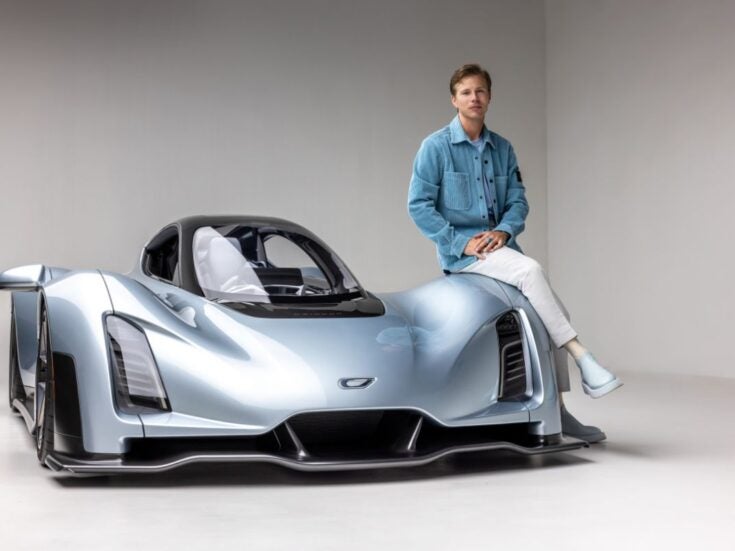
Historic racing cars with a provenance are as collectable as ever today. Anthony Haden-Guest explores the aesthetic of miles-per-hour
The racing car soon made an impact on the art world. The first Grand Prix was in 1906. On 20th February 1909, F T Marinetti’s Manifesto for the Futurist Movement ran in the Paris newspaper, Le Figaro. Clause 4 read: We affirm that the world’s magnificence has been enriched by a new beauty: the beauty of speed.
racing car whose hood is adorned with great pipes, like serpents of explosive breath – a roaring car that seems to ride on grapeshot is more beautiful than the Victory of Samothrace.
No Futurist art as yet existed. It was soon made to order. Futurist paintings look like Cubist images being given a fast shuffle by a professional dealer. Let her rip!
And the racing cars themselves? Actually, the look of the 1908 GP Mercedes-Benz, certainly the greatest of the Edwardian machines, might surprise anybody relying on Marinetti. It’s solid, oblong, and functional-as-a-safe, being mostly engine. It’s a two-seater, the second seat being for the riding mechanic, and it is uncluttered by a windshield.
It does have four pipes – like serpents of explosive breath – and it was capable of astounding onlookers with a speed of 100mph, faster by far than contemporary aeroplanes.
All in all, the Mercedes has the brutalist, no-nonsense look of something constructed according to raw, engineering principles, like an early locomotive or, half a century later, an early spacecraft. The intention of building a racing car was seldom to make a thing of beauty, but something of beauty sometimes resulted anyway.
From then on we see an aesthetic sense slyly insinuating itself into racing cars – as in prehistoric times it had insinuated itself into such rudimentary necessities as clothes and housing. Consider Gabriel Voisin and his brother Charles, French industrial designers who created a rifle, a glider and an automobile.
In 1900, Gabriel was hired as a designer for the Universal Exposition in Paris and in 1906 he and his brother started Frères Voisin, Europe’s first aviation company (Charles was killed in a car accident in 1912). Then, as now, aeroplane and automobile engineering and design interacted, but Voisin was horrified by the military uses to which planes were put in the Great War.
Post-war, he dedicated himself to the automobile. Voisin’s 1923 Grand Prix machine was a watershed. Like the Bugatti ‘Tank’ – more of an upturned desk ink blotter – of the same year, there is something about the look of the machine that can’t be explained in terms of pure engineering, something otherworldly, science-fictive almost.
It is worth noting that Voisin was a friend of the visionary architect, Le Corbusier. In 1924 Le Corbusier conceived of the City of the Future, which he described as ‘a machine for living in’. Fritz Lang’s great movie of 1927, Metropolis, was a warning about the Machine Age, but made it morbidly beautiful. This was the landscape across which the great racing cars roared – but not their finish line. Here are three of them. Look at them as art forms. In part, they are.

ERA B-TYPE
Britain did have Grand Prix racing cars in the 1920s: Sunbeams, made in Wolverhampton. But the company put so much dough into racing that it went into receivership during the financial crises of the late 1920s/early 1930s. The battle was thus left to government-subsidised German and Italian machinery.
On the Continent they would close the public roads and go racing. Street races were ten a penny – except on Britain’s mainland, where such activities were banned. We had Brooklands, the first purpose-built racetrack, instead. A wide, very fast, banked circuit, it was an environment that bred cars unsuited to the twist-turn-stop-go of Continental racing.
English Racing Automobiles Ltd, a company based in Lincolnshire, eventually took up the challenge though, in 1934. Created by a driver, Raymond Mays, a designer, Peter Berthon, and Humphrey Cook, the moneybags, the voiturette, one rung down from GP racers – these cheaper, smaller, lighter, less powerful machines – sated the public’s demand for high-speed spectacle.
The ERA was very successful pre- and post-war, despite its road car-based six-cylinder engine being an old-fashioned pushrod, and despite its lofty stance – just when its Italian rivals were getting lowdown. Indeed, the contemporary joke was that it was ‘English Perpendicular’ – the reference being perhaps to Rolls-Royce, itself borrowing from the statelier horse-drawn coaches.
This ERA is, of course, trimmer – a foxhound, not a Great Dane – but its neat perpendicularity does endow it with a pleasantly Neo-Georgian look. You could imagine it parked outside a country seat of manageable size.
In fact, of course, it belongs on the track, and the colours of this one – deep-sea blue and ripe banana – denote it as one of three raced by Bira. That was Prince Birabongse Bhanutej Bhanubandh, an Old Etonian grandson of the King of Siam. Make that a country seat of unimaginable size.

JAGUAR C-TYPE
William Lyons, a motorcycle enthusiast from Blackpool, built up Swallow Sidecars, and turned it into Jaguar. He had flair for publicity. And Le Mans was where he set up his pre-war stall. Along with the Monaco GP and Indianapolis 500, the 24-hour GP de l’Endurance towers above all other races. In the 1950s, winning it suddenly became huge news because it gave cachet in the States, opening up the world’s biggest market.
Jaguar, however, had a problem. Its XK engine had created the first 120mph production sports car, but at 3.4 litres and 205bhp it looked breathless next to the V12 Ferraris and 5.4-litre Cunninghams.
And, put simply, if you weren’t fast enough down the three-mile Mulsanne Straight, you weren’t going to win Le Mans, no matter how nimble your car was. Hence Jaguar’s push for streamlining. C-type designer Malcolm Sayer was fresh out of aeronautics, and can’t you just see it in this car?
It’s interesting to reflect that this was the same year as the Festival of Britain on London’s South Bank, which was promoted as ‘a tonic for the nation’. But that nation was still bomb-scarred and in the grip of austerity – rationing didn’t end for three more years.
The Festival’s main art event, The Unknown Political Prisoner, was dominated by cheerless, sombre, spiky work, not unnaturally, given its theme, but that was the mood anyway. And here came the Jaguar C-Type – heading into a brighter future.
It won Le Mans in 1951. And then Mercedes turned up with the gullwinged 300SL; Jaguar ace Stirling Moss had one whistle effortlessly past him during the 1952 Mille Miglia. He got on the blower to Coventry to tell them to make the C-type faster, or else. Panic ensued.
A longer nose was put on her, a longer tail too – a real rush job. It wasn’t as pretty – and it didn’t work. Engine cooling had been compromised. The goose was swiftly cooked. So in 1953 Jaguar returned to doing it the way it knew. And won Le Mans again.

MASERATI 250F
Most of the Grands Prix of the 1950s – except for 1954 and 1955 when Mercedes-Benz blew everyone away – were dominated by the ‘bloody red cars’ of the Italians. Fast and beautiful, they made Britain’s efforts look distinctly BRG at the gills.
Italy had the function and the form. Its production sports cars benefited from famous carrozerie (styling houses) run by designers like Sergio Scaglietti, creator of the sensuous Ferrari 250GTO, and Battista ‘Pinin’ Farina, who had designed the Fiat Zero when he was 17, and one of whose cars had been designated as ‘moving sculpture’ by New York’s Museum of Modern Art, and exhibited there in 1947.
Grand Prix racers, though, were almost always styled in-house: Maseratis were; no two were alike, each hammered out of gossamer aluminium by a tubby, blue-collar bloke called Medardo Fantuzzi. He didn’t profess to be a designer. He was a panel-beater. It just so happened that he came up with some fantastic shapes. His 250F is
the épitomé of the front-engined Grand Prix car, its body elegantly elongated during its five seasons (1954 to 1958) in GP’s front line.
Racing function, of course, would eventually overtake it: Britain’s ugly-bug Coopers and soapbox Lotuses fitted their engines in the back, which was smarter engineering. But it was the Maserati that embodied the aesthetic of the future…
…Like the Sayer Jags. His –type triptych was completed when the E- was previewed in Geneva in 1961. Lyons had demanded it be driven there from Coventry and it only just made the show in time, which ensured that it was already a media tour de force on arrival.
Sleekly phallic, it became the most powerful automobile image of the 1960s. It is, I think, fair to say that its sexy brand of minimalist-modernism foreshadowed designers like Andre Courreges – the ‘Le Corbusier of Fashion’ – and his disciple Emanuel Ungaro and, indeed, of the sleek early 1960s discotheques.
Okay, Swinging London. So it was no accident that George Best acquired an E-type – but it is also no accident that Britain’s Arts Council celebrated it with a display, and that one was acquired by New York’s Museum of Modern Art, which devoted a catalogue to it.
A snappy motor car has always had much expected of it: to be state-of-the art design, but also to be a vehicle of suggestion, of desire and of dreams. Motor racing has been key on both accounts.
Our thanks to David Wenman for the loan of his cars.






